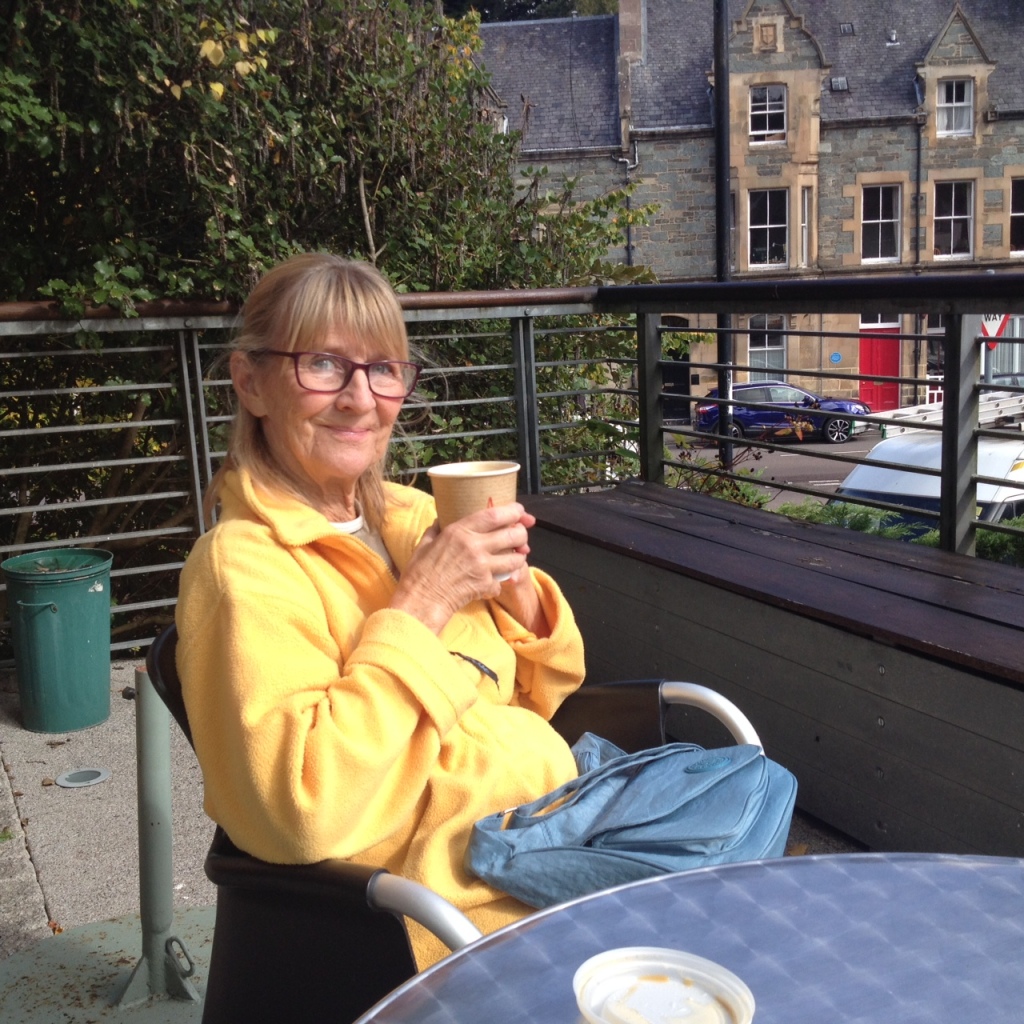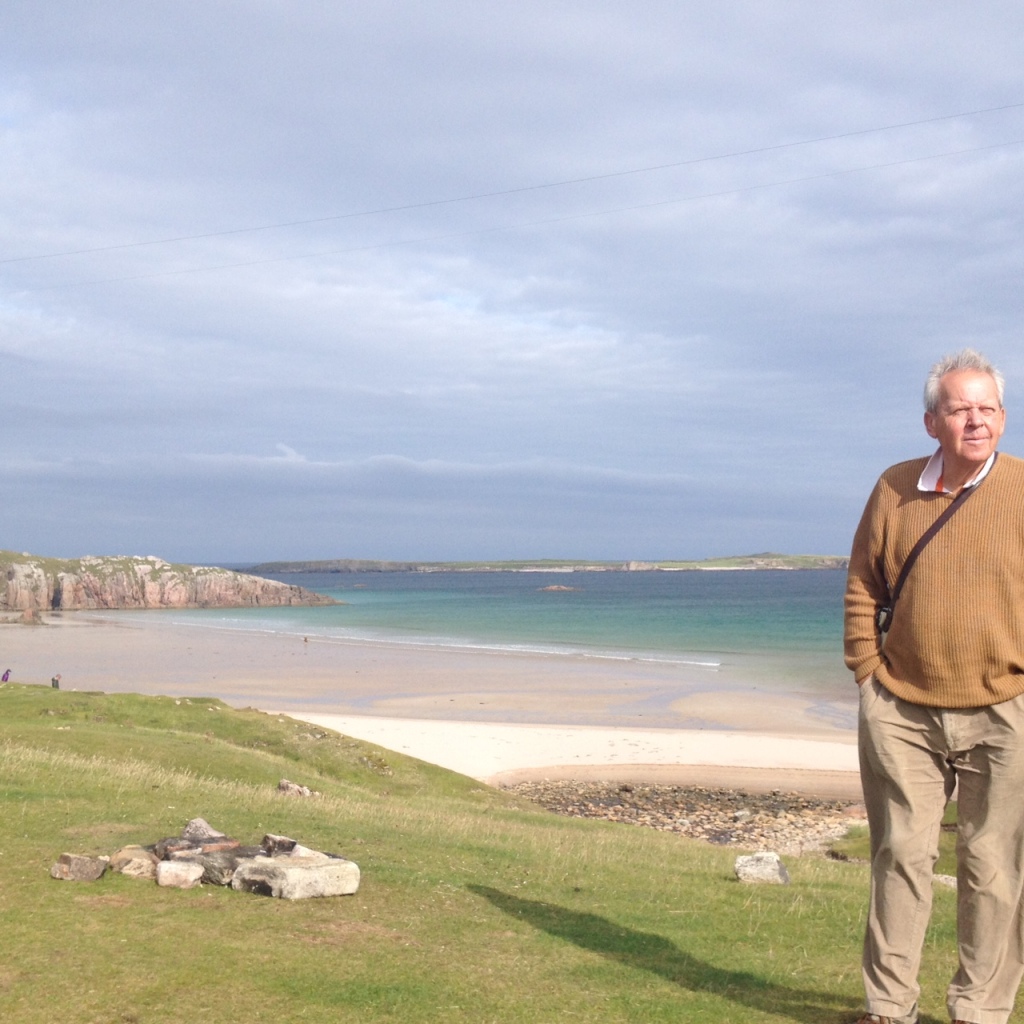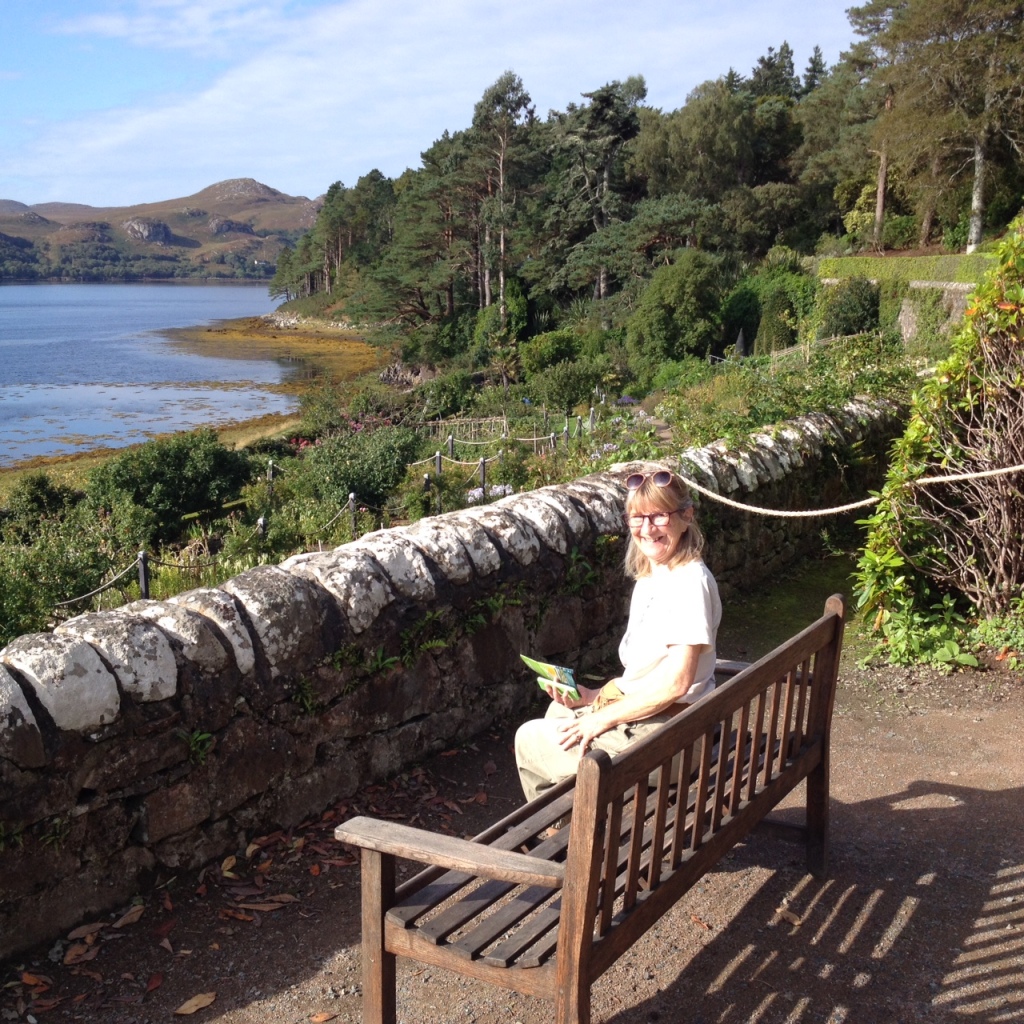May or September are [said to be] the best months for visiting Scotland. After a couple of distinctly autumnal weeks we went north in mid-September more in hope than in expectation. Or to be more precise we went north in a dark red Kia Ceed [they dropped the bizarre apostrophe in 2018]., rented from a friendly garage in Dalkeith. As any septuagenarians reading this will know, hiring a car gets more difficult when you reach seventy-five. Either the answer is a straight ‘No’, or you get landed with a substantially hiked insurance cost.
There were tedious queues on the A9 north of Perth, where they are working on dualling the section towards Dunkeld. But fortified by coffee from the excellent Birnam Arts Centre

cafe, we were in Inverness by the middle of the afternoon. We had booked B&Bs in Inverness and two subsequent stops, but I hadn’t realised that in these COVID times you need to book ahead for meals too. We walked along the river into town, and eventually got a table at the fifth place we tried. It was an Indian restaurant which was refurbishing, but was serving meals in the adjacent cafe.

Confession. We gave church a miss on Sunday morning. [The last time I was in Inverness on a Sunday, I tried with difficulty to find an evening service. Eventually I was directed to the Episcopal cathedral, where I was part of a congregation of four and the service was in the Gaelic !] Instead we had booked a visit to the Culloden Visitors’ centre- advance booking now essential at National Trust properties. The centre didn’t exist when we were last at Culloden. Now the panels tell the story of the background to the 1745 rising, the Hanoverian story on one side, the Jacobite story on the other. The Jacobite army, exhausted after a fruitless night march and hungry because of inadequate provisioning, was destroyed on Culloden Moor in April 1746 by the Hanoverian army under the Duke of Cumberland.

[John Prebble tells me that Cumberland was younger than I had realised. And he seems in some ways to have been a model for the current Prince Andrew.] After a rather slow tour of the exhibition it was good to walk on the battle-field; the lines of the opposing armies marked with flags, and memorial stones showing where the clan chiefs fell.
In the afternoon we visited Fort George, also booked on line. It is an impressive, stone-built eighteenth century barracks, one of a series of Hanoverian military bases [Fort George, Fort Augustus, Fort William] which were built after the 1745 uprising. The Fort sits on a neck of land at the narrowest point of the Moray Firth, looking across to Rosemarkie and Chanonry Point. It contains the Highlanders’ Regimental Museum; dress uniforms, sepia photos, and medals from assorted highland regiments. All fascinating if you like that sort of thing. Which I quite do.

Then on north to Sutherland, named Suôrland [Southern Land] by the Norse in relation to their settlements in Orkney and Shetland. Our base was Armadale House, a Victorian B&B close to the sea, run by Detta, originally from Groningen but who has lived here for the past two decades.

This is rugged, thinly populated country, with a sprinkling of chambered cairns, standing stones, hill forts, and deserted settlements. It sprinkled with rain on Strathy Point, where we failed to spot the whales. But the sun shone on the sea at Torrisdale Bay at Bettyhill. A plaque on the disused ice house overlooking the mouth of the river Naver told us that as late as the 1960s almost a thousand salmon were netted here on a single day.
Sutherland is strongly associated with the Highland Clearances of the early nineteenth century, when villagers were driven off their crofts by landowners who wanted the land for sheep farming. The villains of the story are traditionally the English, epitomised by George Granville Leveson-Gower[1758-1833], an Old Etonian, English aristocrat, landowner and politician, said to the the richest man in England. In addition to his extensive land-holdings in Staffordshire, Shropshire, and Yorkshire, he acquired vast estates in Scotland by his marriage to Elizabeth, 19th Countess of Sutherland. As part of the ‘improvements’ to the Sutherland estate hundred of villagers were forcibly evicted in Strathnaver by Patrick Sellar, one of the Duke’s factors. Bad things certainly happened in Strathnaver, where people were treated cruelly. But it is now generally recognised that the clearances were at least in part the work of the clan chiefs and of incoming Lowland Scots. [Interestingly, in the light of recent controversy about public statues, there is a 100 foot high monument to the Duke of Sutherland on top of Ben Bhraggie, a prominent hill overlooking the village of Golspie in eastern Sutherland. And for a decade or more there have been campaigns to demolish the statue and replace it with a monument to the victims of the Clearances.]

We spent a day meandering down Strathnaver, starting with the deserted clearance village at Aberlochy. Then a roadside monument commemorating the first gathering of The Argyll and Sutherland Highlanders (Princess Louise’s), known after Baklava in the Crimean War as ‘The Thin Red Line’. Then a stone marking the grave of the ‘Red Priest’, an eighth century priest killed by Viking raiders, sometimes identified [wrongly] with Saint Maelrubha. the Irish monk who founded the monastery at Applecross.. Nearby, in a clearing in woodland, what is said to be the Red Priest’s dwelling is in reality a Neolithic chambered cairn. Lunch was a picnic in Naver Forest, and we walked up to Rosal, one of the larger clearance villages set on a hillside above the river.

We came home to Armadale via The Flow Country, a rolling expanse of peatland and wetland, the largest expanse of blanket bog in Europe. It is both a significant wildlife habitat and a major carbon store.
Later in the week we drove west, through Bettyhill and across the causeway at Tongue. A combination of staycations [an ugly neologism] and promotion in recent years of the North Coast 500 has led to a significant increase in visitor numbers. We drove round the bottom end of Loch Eriboll in a procession that included five camper-vans and two Aston-Martins with the hoods down. And we failed to spot where we rough camped forty-plus years ago [see TaGD – 21].

In Durness both Smoo Cave and the John Lennon Memorial Garden [he came here regularly for holidays as a child; and there is an ongoing debate as to whether Durness inspired the song In my life] had both attracted a bunch of camper-vans. We went straight on to Balnakeil where I played golf [very badly] on the nine-hole course overlooking the sea, the most northerly course in the UK; and afterwards we had a hot chocolate from the reputed Cocoa Mountain in the Balnakeil Craft Village.. All melted chocolate and cream and calories.

Our final two nights were at Laide on the edge of Gruinard Bay. We visited the North Sea Convoy Museum at Aultbea. Susie’s father, George Malloch, was a very young medical doctor on the North Sea Convoys, but rarely spoke about the experience. And we re-visited the excellent Inverewe Gardens, a two thousand acre botanical garden created in the 1860s by Osgood Mackenzie and his daughter Mhairi.

And I played golf again at Gairloch in the sunshine, rather better this time, or at least not quite so badly as before, on the charming nine-hole course tucked in behind the beach. And Susie finally swam in the sea at Mellon Udrigle.
And now we are back in Edinburgh again, grateful for a trip away. And wondering when we might get a chance to go away again. Probably not in the near future in view of the rampant second wave.
September 2020
This reminds me of my first visit to Scotland with my husband and a couple of gf french friends some time ago,staying in fantastic b and bs. The one in Inverness was rub by a scots girl and her Nigerian husband. Because they had worked many years at UNESCO in Paris they spoke French and our friends spoke no English! We also stopped in Furness and the door was opened be a delightful young couple speaking broad Yorkshire! Unfortunately we were not able to meet the laird of dunvegan,cousins of my MacLeod relations in France. We had a fabulous trip.
LikeLike